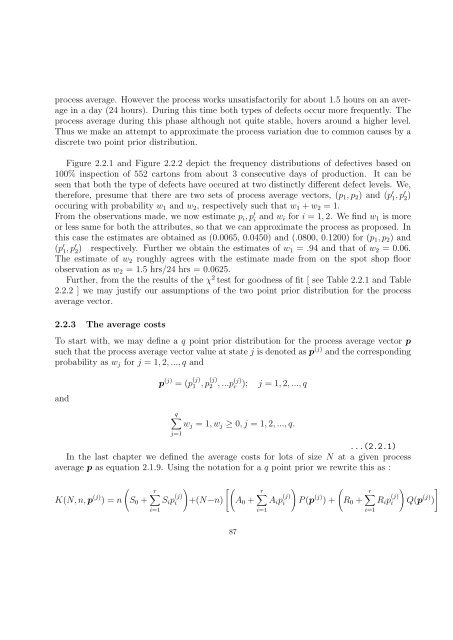Multiattribute acceptance sampling plans - Library(ISI Kolkata ...
Multiattribute acceptance sampling plans - Library(ISI Kolkata ...
Multiattribute acceptance sampling plans - Library(ISI Kolkata ...
You also want an ePaper? Increase the reach of your titles
YUMPU automatically turns print PDFs into web optimized ePapers that Google loves.
process average. However the process works unsatisfactorily for about 1.5 hours on an average<br />
in a day (24 hours). During this time both types of defects occur more frequently. The<br />
process average during this phase although not quite stable, hovers around a higher level.<br />
Thus we make an attempt to approximate the process variation due to common causes by a<br />
discrete two point prior distribution.<br />
Figure 2.2.1 and Figure 2.2.2 depict the frequency distributions of defectives based on<br />
100% inspection of 552 cartons from about 3 consecutive days of production. It can be<br />
seen that both the type of defects have occured at two distinctly different defect levels. We,<br />
therefore, presume that there are two sets of process average vectors, (p 1 , p 2 ) and (p ′ 1, p ′ 2)<br />
occuring with probability w 1 and w 2 , respectively such that w 1 + w 2 = 1.<br />
From the observations made, we now estimate p i , p ′ i and w i for i = 1, 2. We find w 1 is more<br />
or less same for both the attributes, so that we can approximate the process as proposed. In<br />
this case the estimates are obtained as (0.0065, 0.0450) and (.0800, 0.1200) for (p 1 , p 2 ) and<br />
(p ′ 1, p ′ 2) respectively. Further we obtain the estimates of w 1 = .94 and that of w 2 = 0.06.<br />
The estimate of w 2 roughly agrees with the estimate made from on the spot shop floor<br />
observation as w 2 = 1.5 hrs/24 hrs = 0.0625.<br />
Further, from the the results of the χ 2 test for goodness of fit [ see Table 2.2.1 and Table<br />
2.2.2 ] we may justify our assumptions of the two point prior distribution for the process<br />
average vector.<br />
2.2.3 The average costs<br />
To start with, we may define a q point prior distribution for the process average vector p<br />
such that the process average vector value at state j is denoted as p (j) and the corresponding<br />
probability as w j for j = 1, 2, ..., q and<br />
and<br />
p (j) = (p (j)<br />
1 , p (j)<br />
2 , ...p (j)<br />
r ); j = 1, 2, ..., q<br />
q∑<br />
w j = 1, w j ≥ 0, j = 1, 2, ..., q.<br />
j=1<br />
...(2.2.1)<br />
In the last chapter we defined the average costs for lots of size N at a given process<br />
average p as equation 2.1.9. Using the notation for a q point prior we rewrite this as :<br />
K(N, n, p (j) ) = n<br />
(<br />
S 0 +<br />
r∑<br />
i=1<br />
) [(<br />
S i p (j)<br />
i +(N−n) A 0 +<br />
r∑<br />
i=1<br />
)<br />
(<br />
A i p (j)<br />
i P (p (j) ) + R 0 +<br />
r∑<br />
i=1<br />
) ]<br />
R i p (j)<br />
i Q(p (j) )<br />
87
















